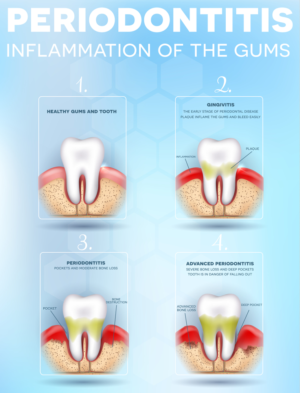Periodontal Disease: What is it?

Periodontal disease, also referred to as gum disease, is very common and treatable. But do not underestimate it, it is the leading cause of tooth loss in adults. Today, we will go over what periodontal disease is and the relationship between it and diabetes.
To begin, you must first understand what periodontal disease is exactly. By definition, it is an inflammation and infection of the area surrounding a tooth. This inflammation can lead to gum recession, bone loss, or a total loss of the tooth. There are several different stages and warning signs to look for.
The Stages
There are several stages and signs of gum disease, the first stage being gingivitis. Gingivitis is described as being a mild form of periodontal disease and can be easily reversed at the periodontal office. The signs include inflammation, an irritation in the gums, redness and/or swelling. If not properly cared for, it can develop into periodontitis. It is, at this stage, that the tissue and bone begin to suffer. If it continues to go untreated, the periodontitis will wear away the bone to the point of loosening the teeth; leading to tooth loss or the need for extraction.
Additionally, some warning signs include: a change in your bite, bad breath, loose teeth, gums pulling away from teeth, bleeding, sensitivity, or signs of infection.

The Correlation with Diabetes
Diabetes and gum disease go hand in hand; one affects the other. Having diabetes can cause a more severe case of gum disease and extend the process. In addition, having gum disease can make it more difficult to keep your blood glucose, sugar, levels under control. Periodontal disease can cause these levels to rise in people with or without diabetes; potentially leading to Type II diabetes.
Glucose can be found in the saliva in your mouth. If the levels are too high this can cause harmful bacteria to develop. The bacteria that forms, when combined with food, creates plaque. Plaque is the word we are all too familiar with hearing at our dental visits. Plaque is described as being a sticky, colorless film that continuously grows on your teeth; this is what we are always fighting by brushing and flossing several times a day. If not properly removed, plaque mineralizes into tartar, which can only be removed at the dental office. Tartar, when not properly removed, may lead to gum disease. Therefore, you should always keep up with with your dental visits.
As shown above, periodontal disease is not to be taken lightly, especially considering the risk of developing other illnesses such as diabetes. Many people think it is nothing to be concerned about if you find that your gums are bleeding when brushing or flossing when it is quite the contrary. As described on the Colgate website, if your hands bled every time you washed them, you’d be concerned!


